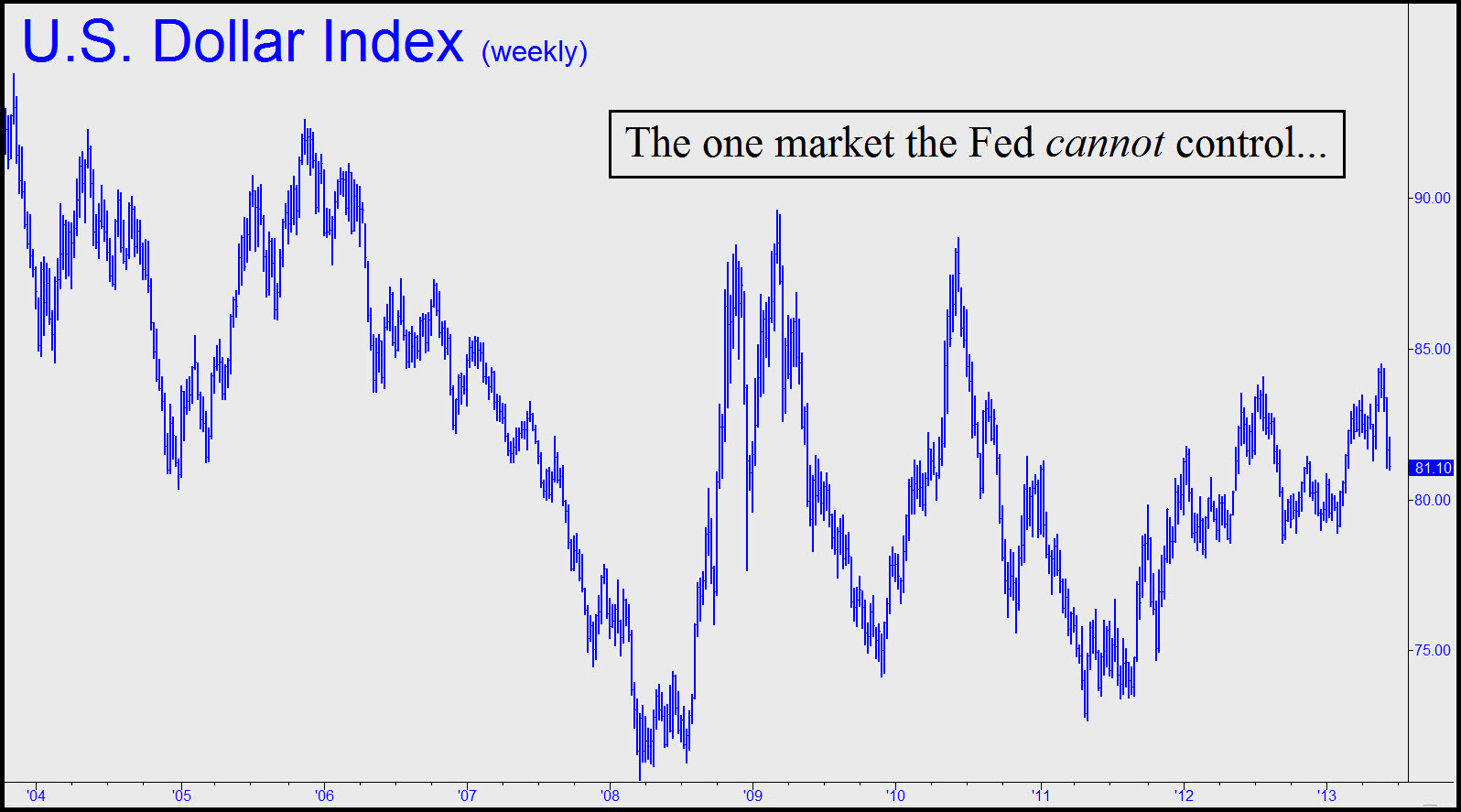Well, that’s two straight Tuesdays that U.S. stocks have fallen. Has Wall Street finally noticed that the real estate sector – the only big winner in American’s sham “recovery” besides the stock market itself – is starting to deteriorate? Hard to say, although lately, we’ve had our doubts that yield-crazed U.S. investors would lose a beat even if an epidemic were to wipe out half of the world’s population. They barely flinched a couple of weeks ago when Japan’s stock market was freefalling. And if deepening recession in Europe and a steep drop in China’s output bode trouble ahead for the global economy, neither factor has had a noticeable impact on U.S. stocks, which touched record highs as recently as two weeks ago.
Now, however, comes a worry that will literally hit investors where they live: a steep increase in long-term yields that has pushed 30-year mortgage rates up by 56 basis points in just the last five weeks. As our colleague Michael Belkin notes, this is equivalent to two rate hikes by the Federal Reserve. An immediately visible result, he says, is that mortgage applications dropped 11% last week and mortgage lenders are starting to lay off brokers.
If home sales start to cool even slightly, we wouldn’t be surprised if the “wealth effect” that the Fed has struggled so hard to create over the last five years vanishes in a trice, since Americans have precious few things these days, other than inflated home values, to make them feel wealthier. (Certainly not higher real incomes, which have stagnated since the 1970s.)
From a technical standpoint, T-Bond futures still have a little room to fall before they hit our red zone. That would imply a drop to around 137-7/32, basis the September contract. (Note: yesterday’s low was 137-25/32.)
In recent years, the Fed has moved aggressively to reverse the bearish tide when it reached or slightly exceeded our proprietary “Hidden Pivot” targets. Although the futures got a strong bounce yesterday off the lows, we still expect a relapse that will bring them even closer to the danger zone. Market-watchers should pay close attention if and when 137-7/32 is approached, since a decisive breach of that price – implying a move below 137 – could imply that market forces are beginning to push back against Fed stimulus.
End Easing? Get Real!
We have repeatedly emphasized here that worries about the central bank tapering off its quantitative easing program are way overblown, since even a mere hint that the Fed would be willing to seriously consider such an option has sent stocks into violent swoons and spasms. However, if market forces were to cause long-term yields to rise even another 50 basis points, that could jolt the markets severely.
What might give rise to such “market forces”? Most obviously, weakness in the U.S. dollar. The greenback has been leaden over the last two weeks, raising doubts about whether its status as the world’s safe-haven currency can endure indefinitely. Probably not, but our hunch is that the current bull market will resume once investors get over their misplaced fear that Japan is done trashing its own currency.
In any case, the ICEUS Dollar Index, currently trading for around 81.11, still has further to fall before reaching our correction target. If this forecast is correct, you should look for the bull market in the dollar to regain traction from 80.66, or if any lower, 80.19.
- English (UK)
- English (India)
- English (Canada)
- English (Australia)
- English (South Africa)
- English (Philippines)
- English (Nigeria)
- Deutsch
- Español (España)
- Español (México)
- Français
- Italiano
- Nederlands
- Português (Portugal)
- Polski
- Português (Brasil)
- Русский
- Türkçe
- العربية
- Ελληνικά
- Svenska
- Suomi
- עברית
- 日本語
- 한국어
- 简体中文
- 繁體中文
- Bahasa Indonesia
- Bahasa Melayu
- ไทย
- Tiếng Việt
- हिंदी
The Housing Boomlet’s ‘Elephant In The Room’
Published 06/12/2013, 12:09 AM
Updated 07/09/2023, 06:31 AM
The Housing Boomlet’s ‘Elephant In The Room’
3rd party Ad. Not an offer or recommendation by Investing.com. See disclosure here or
remove ads
.
Latest comments
Install Our App
Risk Disclosure: Trading in financial instruments and/or cryptocurrencies involves high risks including the risk of losing some, or all, of your investment amount, and may not be suitable for all investors. Prices of cryptocurrencies are extremely volatile and may be affected by external factors such as financial, regulatory or political events. Trading on margin increases the financial risks.
Before deciding to trade in financial instrument or cryptocurrencies you should be fully informed of the risks and costs associated with trading the financial markets, carefully consider your investment objectives, level of experience, and risk appetite, and seek professional advice where needed.
Fusion Media would like to remind you that the data contained in this website is not necessarily real-time nor accurate. The data and prices on the website are not necessarily provided by any market or exchange, but may be provided by market makers, and so prices may not be accurate and may differ from the actual price at any given market, meaning prices are indicative and not appropriate for trading purposes. Fusion Media and any provider of the data contained in this website will not accept liability for any loss or damage as a result of your trading, or your reliance on the information contained within this website.
It is prohibited to use, store, reproduce, display, modify, transmit or distribute the data contained in this website without the explicit prior written permission of Fusion Media and/or the data provider. All intellectual property rights are reserved by the providers and/or the exchange providing the data contained in this website.
Fusion Media may be compensated by the advertisers that appear on the website, based on your interaction with the advertisements or advertisers.
Before deciding to trade in financial instrument or cryptocurrencies you should be fully informed of the risks and costs associated with trading the financial markets, carefully consider your investment objectives, level of experience, and risk appetite, and seek professional advice where needed.
Fusion Media would like to remind you that the data contained in this website is not necessarily real-time nor accurate. The data and prices on the website are not necessarily provided by any market or exchange, but may be provided by market makers, and so prices may not be accurate and may differ from the actual price at any given market, meaning prices are indicative and not appropriate for trading purposes. Fusion Media and any provider of the data contained in this website will not accept liability for any loss or damage as a result of your trading, or your reliance on the information contained within this website.
It is prohibited to use, store, reproduce, display, modify, transmit or distribute the data contained in this website without the explicit prior written permission of Fusion Media and/or the data provider. All intellectual property rights are reserved by the providers and/or the exchange providing the data contained in this website.
Fusion Media may be compensated by the advertisers that appear on the website, based on your interaction with the advertisements or advertisers.
© 2007-2024 - Fusion Media Limited. All Rights Reserved.
